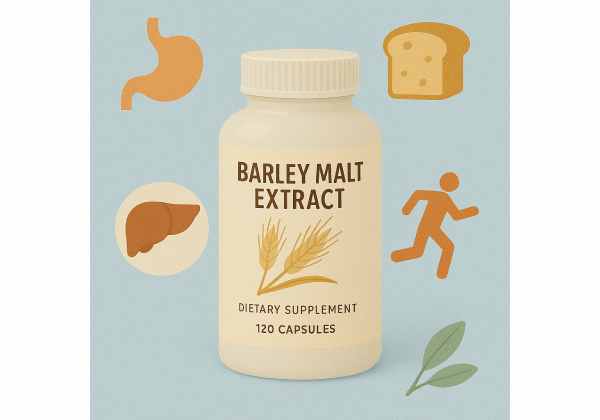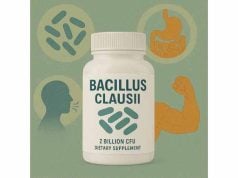
What gives your favorite bread, cereal, or beverage its subtle sweetness and robust flavor? Barley malt extract—a golden syrup made from sprouted barley grains—has earned a reputation as both a natural sweetener and a supplement for digestion, energy, and wellness. Barley malt extract delivers more than flavor: it’s a source of unique enzymes, prebiotic fiber, vitamins, and minerals that support gut health, steady energy, and even heart wellness. This guide will walk you through what barley malt extract is, how it works in your body, key science-backed benefits and common uses, ideal dosage and timing, potential side effects, and the answers to the most frequently asked questions. Let’s break down everything you need to know to use barley malt extract for both nutrition and wellness.
Key Takeaways
- Barley malt extract is a natural sweetener and functional supplement made from sprouted, enzymatically active barley grains.
- Its benefits include supporting digestive health, boosting energy, aiding mineral absorption, and adding flavor to foods and drinks.
- Generally recognized as safe in food amounts, but contains gluten and may affect people with celiac disease or gluten intolerance.
- Recommended daily usage is 1–2 tablespoons for most, but exact dosage varies with dietary and supplement goals.
- Available in liquid, powder, and capsule form; best used as part of a balanced diet or targeted wellness protocol.
Table of Contents
- Barley Malt Extract Overview: Ingredients and Traditional Uses
- How Barley Malt Extract Supports Wellness: Science and Bioactive Components
- Key Benefits and Evidence-Based Uses of Barley Malt Extract
- Barley Malt Extract Safety, Tolerability, and Possible Side Effects
- Recommended Dosage and Optimal Usage of Barley Malt Extract
- Barley Malt Extract Frequently Asked Questions (FAQ)
Barley Malt Extract Overview: Ingredients and Traditional Uses
Barley malt extract is a thick, dark syrup or powder created by sprouting barley grains, allowing them to germinate, and then heating and mashing the sprouted grains to release their natural sugars and enzymes. The liquid extract is then concentrated to produce the familiar, richly flavored syrup or dried into a fine powder.
What’s in Barley Malt Extract?
- Complex Carbohydrates: The primary component is maltose, a natural sugar that is slowly digested and provides sustained energy.
- Enzymes: Malt extract is rich in amylase and other enzymes that help break down starches, both in food preparation and digestion.
- Vitamins & Minerals: Contains B vitamins (especially niacin, riboflavin, and B6), magnesium, potassium, iron, and selenium.
- Amino Acids: Offers small amounts of essential and non-essential amino acids.
- Prebiotic Fiber: Soluble fiber in malt extract can help nourish beneficial gut bacteria.
Traditional and Modern Uses
Barley malt extract has a long-standing place in both culinary and wellness traditions:
- Food and Beverage: Used to sweeten bread, cereals, bagels, beer, malted milk, and energy bars. The enzymes in malt extract are prized for helping yeast rise and improving bread texture.
- Digestive Health: Traditionally used as a gentle laxative, mild digestive tonic, and to promote appetite in children and adults.
- Energy and Recovery: The slow-release carbohydrates provide fuel for athletes, those recovering from illness, or anyone needing sustained energy.
Natural Sweetener and Beyond
Barley malt extract is valued for its low glycemic index, deep molasses-like taste, and “clean label” reputation as a minimally processed food ingredient.
Forms Available
- Liquid Syrup: Most common, easy to mix into recipes and beverages.
- Powdered Extract: Convenient for baking and smoothies.
- Capsules/Tablets: Less common, used for targeted supplementation.
Who Should Consider Barley Malt Extract?
- Home bakers seeking natural leavening and sweetening
- People with mild digestive sluggishness or low appetite
- Athletes and those needing a gentle, steady energy source
- Anyone wanting to reduce refined sugars in their diet
Summary Table: Barley Malt Extract Essentials
| Aspect | Details |
|---|---|
| Main ingredient | Sprouted, malted barley grain |
| Key nutrients | Maltose, B vitamins, minerals, enzymes |
| Core uses | Sweetener, digestion, energy, baking |
| Forms | Syrup, powder, capsule |
| Gluten content | Contains gluten; not safe for celiac |
Barley malt extract combines a rich history with modern versatility, making it a staple for both kitchens and wellness plans.
How Barley Malt Extract Supports Wellness: Science and Bioactive Components
Barley malt extract’s wellness benefits aren’t just the result of its flavor; they come from the unique way it is made and the spectrum of nutrients it retains. The malting process transforms raw barley grains, activating their enzyme systems and making key nutrients more bioavailable. Here’s how those components work together for holistic health support.
1. Enzyme Activity and Digestive Support
- Amylase and Protease: The malting process increases these enzymes, which help break down starches and proteins both during baking and in your digestive system.
- Prebiotic Fiber: Barley malt contains beta-glucans and other soluble fibers that feed beneficial gut bacteria, promoting a healthy microbiome and supporting regularity.
2. Natural Carbohydrates and Energy
- Maltose: Unlike refined sugars, maltose is broken down slowly, providing sustained energy and minimizing blood sugar spikes. This makes it ideal for athletes, growing children, and anyone seeking a balanced energy source.
- Low Glycemic Index: The steady glucose release helps maintain even energy and mood, reducing cravings for high-sugar foods.
3. Micronutrient Delivery
- B Vitamins: Essential for converting food into energy, supporting brain function, and aiding in stress management.
- Minerals: Magnesium and potassium support muscle and nerve function; iron aids in oxygen transport; selenium and zinc offer antioxidant and immune benefits.
4. Antioxidant Compounds
- Phenolics and Melanoidins: The malting and gentle heating process produces antioxidant compounds that can help neutralize free radicals and protect cells from oxidative damage.
5. Alkaline Effect and Mineral Absorption
- Alkalizing Power: While barley grain is slightly acidic, the sprouted extract can help balance acidity in the diet and may assist with mineral absorption, especially magnesium and calcium.
Why the Sprouting Process Matters
Sprouting (malting) activates dormant enzymes and increases vitamin and mineral content. It also reduces certain anti-nutrients (like phytic acid) that can otherwise block mineral absorption.
How the Components Work Together
- Aid digestion and gentle detoxification
- Support a balanced, healthy gut
- Deliver sustainable, long-lasting energy
- Improve nutrient absorption
- Enhance flavor and texture in food and drink
Summary Table: Barley Malt Extract Bioactive Profile
| Component | Main Role/Benefit |
|---|---|
| Amylase/enzymes | Starch breakdown, digestive aid |
| Maltose | Steady energy, low glycemic sweetener |
| Beta-glucans | Prebiotic, supports gut health |
| B vitamins | Energy metabolism, nerve function |
| Minerals | Muscle, bone, and immune support |
| Antioxidants | Cellular protection |
Barley malt extract offers a science-backed bridge between natural sweetness, gentle digestion, and real nutrition.
Key Benefits and Evidence-Based Uses of Barley Malt Extract
Barley malt extract’s reputation as a “functional sweetener” is only the beginning. Its benefits extend far beyond flavor, making it a sought-after ingredient for health, wellness, and cooking.
1. Digestive Regularity and Prebiotic Support
Barley malt extract is prized for its gentle laxative effect, especially in children and older adults with sluggish digestion. Its prebiotic fibers help:
- Feed beneficial gut bacteria, promoting balance in the microbiome.
- Increase short-chain fatty acid (SCFA) production, supporting colon health and immune function.
- Improve regularity without harsh stimulants.
2. Balanced Energy and Sports Nutrition
Unlike refined sugars, the carbohydrates in barley malt extract are slowly digested. This provides:
- Sustained energy for endurance athletes, busy professionals, and kids.
- Reduced risk of energy “crashes” or spikes in blood sugar.
- Excellent pre- or post-workout fuel, especially in smoothies or shakes.
3. Nutrient Density for Growth and Recovery
Barley malt extract supplies B vitamins, iron, magnesium, and potassium—crucial nutrients for:
- Children, teens, and athletes with higher nutritional needs.
- People recovering from illness, surgery, or malnutrition.
- Supporting red blood cell formation and oxygen delivery.
4. Heart and Metabolic Health
- Beta-glucans help lower LDL (“bad”) cholesterol.
- Steady-release carbohydrates support balanced blood sugar.
- Potassium and magnesium contribute to healthy blood pressure.
5. Flavor Enhancement in Cooking
Barley malt extract imparts:
- Natural sweetness with a complex, malted flavor.
- A golden color and soft crumb in breads and baked goods.
- Enhanced yeast activity in homemade bread, bagels, or pizza dough.
6. Appetite Stimulation and Nutritional Support
Traditionally, barley malt extract has been used to increase appetite and nutritional intake in:
- Children with poor appetite or picky eating habits
- Adults or seniors recovering from illness
- Individuals needing additional calories in a gentle, digestible form
7. Potential Antioxidant and Immune Support
Emerging research highlights the antioxidant capacity of malt extract’s polyphenols and melanoidins, which may help:
- Protect against oxidative stress and inflammation
- Support a healthy immune response
Who Benefits Most from Barley Malt Extract?
- Athletes needing clean, sustained fuel
- People with digestive sluggishness or low appetite
- Anyone replacing refined sugars with a natural alternative
- Bakers seeking optimal bread rise and flavor
Summary Table: Barley Malt Extract’s Top Uses
| Benefit/Use | Details |
|---|---|
| Digestive regularity | Prebiotic fiber, gentle laxative |
| Steady energy | Slow carbs, low glycemic impact |
| Nutritional support | Vitamins, minerals, amino acids |
| Heart/metabolic health | Cholesterol and blood sugar support |
| Baking/cooking | Sweetener, flavor, yeast activator |
| Immune/antioxidant | Polyphenols, melanoidins |
From kitchens to sports fields, barley malt extract delivers versatile, evidence-backed advantages that support wellness and flavor.
Barley Malt Extract Safety, Tolerability, and Possible Side Effects
Barley malt extract is widely recognized as safe when used in culinary amounts or as a supplement for most adults and children. However, like all concentrated foods and supplements, it is important to understand its tolerability, possible side effects, and who should use extra caution.
General Safety Overview
Barley malt extract has a long track record of safe use in baking, beverages, and dietary supplementation. Its natural composition of slow-digesting carbohydrates, prebiotic fiber, and micronutrients makes it gentle on most digestive systems. Still, individual reactions can vary—especially for those with allergies or metabolic conditions.
Potential Side Effects
Most people tolerate barley malt extract without issue, but some may experience:
- Digestive Changes: In larger doses, or if your gut isn’t used to prebiotic fiber, you may notice gas, bloating, or mild abdominal discomfort. These symptoms typically resolve with continued use or by reducing dosage.
- Blood Sugar Fluctuations: Though barley malt extract has a lower glycemic index than table sugar, it is still a carbohydrate-rich food and can affect blood glucose, especially if consumed in excess or by people with diabetes.
- Allergic Reactions: Rarely, individuals with grain or barley allergies may experience hives, itching, swelling, or even difficulty breathing. Discontinue use and seek medical care if you notice any allergic symptoms.
- Weight Gain: Overconsumption can add extra calories to the diet, potentially contributing to unwanted weight gain, especially if not balanced within an active lifestyle.
Who Should Be Extra Cautious?
- Celiac Disease and Gluten Sensitivity: Barley malt extract contains gluten and is not safe for anyone with celiac disease or non-celiac gluten sensitivity. Even trace amounts may trigger symptoms or gut damage in these populations.
- Diabetes or Pre-diabetes: While barley malt extract’s carbs are slowly absorbed, they still impact blood sugar. If you have blood sugar issues, use only under medical guidance, monitor levels, and opt for small amounts.
- Children and Pregnant Women: Generally safe in food-like doses, but consult your pediatrician or prenatal provider before starting any supplement during pregnancy or for young children.
- Severe Allergies to Barley or Grains: Avoid all barley-derived products, including malt extract, if you have diagnosed allergies.
Interactions with Medications
Barley malt extract is not known for significant drug interactions but consider the following:
- Blood Sugar Medications: May require dose adjustment if used regularly in people with diabetes.
- Weight Loss Drugs: Adds carbohydrates and calories; be mindful if following a calorie-restricted or medically supervised diet.
Other Safety Considerations
- Dental Health: Like all sweeteners, barley malt extract can contribute to tooth decay if used frequently and oral hygiene is neglected.
- Cross-Contamination: Choose products from facilities that test for allergens and gluten if you have related sensitivities.
Best Practices for Safe Use
- Start with a small serving (e.g., 1 teaspoon per day) and increase as tolerated.
- Pair with fiber-rich foods, protein, or healthy fats to blunt any rapid effects on blood sugar.
- Drink plenty of water, as prebiotic fiber works best when hydrated.
- Store the syrup or powder in a cool, dry place to avoid spoilage or clumping.
Signs to Discontinue Use
- Persistent digestive upset, rash, or hives
- Unexpected fatigue or blood sugar spikes
- Any signs of an allergic reaction
Summary Table: Barley Malt Extract Safety Profile
| Group/Condition | Caution or Action | Why/Notes |
|---|---|---|
| Gluten/celiac | Avoid | Contains gluten |
| Diabetics | Monitor, limit | Impacts blood sugar |
| Allergic individuals | Avoid | Barley, grain protein allergy |
| Pregnant/children | Consult provider | Safe in food amounts |
| Everyone | Practice moderation, good hygiene | Prevent side effects, tooth decay |
Bottom Line on Safety
Barley malt extract is safe and gentle for most people when used appropriately. Be mindful of your health status, dietary goals, and any sensitivities to grains or gluten. If you have specific medical conditions or use medications, talk to your doctor or nutritionist before adding barley malt extract to your regimen.
Recommended Dosage and Optimal Usage of Barley Malt Extract
Knowing how much barley malt extract to use—and how best to incorporate it into your diet—helps you maximize its benefits while keeping your intake balanced and safe. Dosage varies with your health goals, dietary needs, and the specific form you use (liquid, powder, or supplement).
Typical Dosage Guidelines
- Culinary Use (Sweetener): For most adults and teens, 1–2 tablespoons (15–30 grams) of syrup per day is a common amount when used as a sweetener in food or drink. For powder, 1–2 teaspoons (5–10 grams) is typical.
- Digestive or Appetite Support: 1–2 teaspoons (5–10 grams) once or twice daily, ideally with a meal.
- Athletic Fuel: Up to 1–2 tablespoons in pre- or post-workout shakes, combined with other carbohydrates and protein.
- Supplemental Capsules/Tablets: Follow product-specific dosing instructions; these generally provide 500–1,000 mg of extract per serving.
How to Take Barley Malt Extract
- In Baking: Replace sugar, honey, or molasses with equal amounts of malt extract in bread, bagels, muffins, or cookies for a richer flavor and golden color.
- In Beverages: Dissolve syrup or powder in warm water, milk, or plant-based drinks. Mix with protein powders, smoothies, or homemade energy bars.
- As a Tonic: Take by the spoonful or mix into herbal teas for gentle digestive and energy support.
- Pairings: Works well with oats, yogurt, nut butters, and fruit for a balanced snack or breakfast.
Best Times to Use
- Morning: For energy, appetite, or breakfast sweetening.
- Before or after exercise: For sustained fuel and recovery.
- As needed: To support digestion or as a mild laxative.
Tips for Optimal Use
- Start with a small amount to assess tolerance and prevent digestive upset.
- Adjust dosage for activity level: active individuals and athletes may need more.
- Combine with whole foods for steady energy and better blood sugar balance.
- Store in an airtight container in a cool, dry place to maintain freshness.
Who May Need Less or More
- Less: Diabetics, people on calorie-restricted diets, those aiming for weight loss.
- More: Endurance athletes, individuals with increased energy or nutrient needs, those with poor appetite (with doctor approval).
How Long Does It Take to Work?
- Digestive effects: Often noticeable within 1–3 days of consistent use.
- Energy and nutrition: Benefits are felt after a week or two of regular intake.
- Baking/cooking: Immediate functional and flavor improvement.
Sample Daily Routine
- Breakfast: 1 tsp in oatmeal or yogurt
- Lunch: Add to smoothie or homemade snack bar
- Pre-workout: 1 tbsp in energy drink or shake
Summary Table: Dosage and Usage
| Use Case | Typical Dose | How to Take | Best For |
|---|---|---|---|
| Sweetener | 1–2 tbsp syrup | Baking, hot cereals, drinks | Everyday diet |
| Digestive aid | 1–2 tsp powder/syrup | With/after meals | Occasional support |
| Sports nutrition | 1–2 tbsp syrup | In shakes, before/after | Athletes, active adults |
| Supplement | 500–1,000 mg caps | As directed | Targeted wellness goals |
Always tailor usage to your body’s response, dietary goals, and professional guidance.
Barley Malt Extract Frequently Asked Questions (FAQ)
What is barley malt extract used for?
Barley malt extract is commonly used as a natural sweetener in baking and beverages, a digestive tonic, an energy booster for athletes, and to enhance flavor and texture in breads and cereals.
Is barley malt extract gluten-free?
No, barley malt extract contains gluten and is not safe for people with celiac disease or gluten sensitivity. Always avoid barley-derived products if you must be gluten-free.
How much barley malt extract should I take per day?
For most healthy adults, 1–2 tablespoons (15–30 grams) per day is considered safe for culinary and mild wellness use. Start with less and increase slowly as needed.
Does barley malt extract raise blood sugar?
Barley malt extract contains slowly digested carbohydrates that can still affect blood sugar. People with diabetes or insulin resistance should monitor their response and limit intake, using it only under medical supervision.
Are there any side effects of barley malt extract?
Most people tolerate it well, but large amounts may cause digestive upset, mild bloating, or contribute to weight gain. Allergic reactions are rare but possible in those with grain allergies.
Can children and pregnant women use barley malt extract?
It is generally safe in food amounts, but pregnant women and children should consult a healthcare provider before using concentrated supplements or medicinal doses.
What is the difference between barley malt extract and malted barley flour?
Barley malt extract is a concentrated syrup or powder with a higher sugar and enzyme content, while malted barley flour is ground from dried, sprouted barley and used primarily for baking texture and rise.
Disclaimer:
This guide is for educational purposes only and does not constitute medical or dietary advice. Always speak with your healthcare provider before starting any new supplement, especially if you have allergies, medical conditions, or take prescription medications.
If you found this article useful, please share it with friends or family on Facebook, X (formerly Twitter), or your favorite social platform—and follow us for more evidence-based wellness content. Your support helps us continue creating trusted health resources for everyone.










